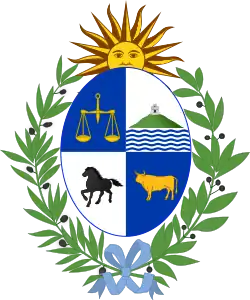 | |
United States |
Uruguay |
|---|---|


Relations between the United States and the Uruguay traditionally have been positive, based on a common outlook and emphasis on democratic ideals.
History
In historical perspective, starting in the 1890s Uruguay took the lead in reaching out to the U.S. in order to counter the heavy British business presence. The U.S. responded in friendly fashion. Knarr argues:
- The United States did not need to coerce Uruguay economically, politically, or militarily to achieve its goals; Uruguay was a friendly and stable nation that the United States could use as an economic and political gateway into the Southern Cone.[1]
In 2002, The United States and Uruguay created a Joint Commission on Trade and Investment (JCTI) to exchange ideas on a variety of economic topics. In March 2003, the JCTI identified six areas of concentration until the eventual signing of the Free Trade Area of the Americas (FTAA): customs issues, intellectual property protection, investment, labor, environment, and trade in goods. In late 2004, the United States and Uruguay signed an Open Skies Agreement, which was ratified in May 2006. In November 2005, they signed a Bilateral Investment Treaty (BIT), which entered into force on November 1, 2006. A Trade and Investment Framework Agreement (TIFA) was signed in January 2007. More than 80 U.S.-owned companies operate in Uruguay, and many more market U.S. goods and services.
Uruguay cooperates with the U.S. on law enforcement matters such as regional efforts to fight drug trafficking and terrorism. It has also been very active in human rights issues.
From 1999 through early 2003, Uruguayan citizens were exempted from visas when entering the United States under the Visa Waiver Program. This exemption was withdrawn on April 16, 2003, based on the high overstay rates for Uruguayans and worldwide national security concerns.
Under Tabaré Vázquez, President of Uruguay from 2005 to 2010 and 2015 to 2020, Uruguay has taken positions on a number of issues which are very markedly different from those of the United States. However, under his right-wing successor, president Luis Lacalle Pou, since 2020, United States-Uruguay relations have again improved and strengthened.[2] Nevertheless, Vázquez sought the help of President George W Bush in the face of the crisis with Argentina around the Uruguay River pulp mill dispute.[3]
According to the 2012 U.S. Global Leadership Report, 40% of Uruguayans approve of U.S. leadership, with 22% disapproving and 38% uncertain.[4]
Principal U.S. Embassy officials
- Chargé d'Affaires--Karl Ríos
Principal Uruguayan Embassy officials
- Ambassador--Andrés Durán Hareau
Resident diplomatic missions
- United States has an embassy in Montevideo.
- Uruguay has an embassy in Washington, D.C., and has consulates-general in Chicago, Miami, New York City and San Francisco.
 Embassy of the United States in Montevideo
Embassy of the United States in Montevideo Embassy of Uruguay in Washington, D.C.
Embassy of Uruguay in Washington, D.C.
Country comparison
| Coat of Arms |  |
.svg.png.webp) |
| Flag |  |
 |
| Population | 3,286,314[5] | 335,917,000 |
| Area | 176,215 km2 (68,036 sq mi) | 9,526,468 km2 (3,794,066 sq mi)[6] |
| Population density | 18.6/km2 (48.3/sq mi) | 31/km2 (80/sq mi) |
| Capital | Montevideo | Washington, D.C. |
| Largest city | Montevideo – 1,305,082 ( 1,947,604 Metro) | New York City – 8,175,133 (19,006,798 Metro) |
| Government | Unitary presidential constitutional republic | Federal presidential constitutional republic |
| First Leader | Fructuoso Rivera | George Washington |
| Current Leader | Luis Lacalle Pou | Joe Biden |
| Official languages | Spanish | English (de facto) |
| Main religions | 58.2% Christianity (47.1% Roman Catholic, 11.1% Protestant), 40.4% non-religious, 0.6% Umbanda, 0.5% Judaism, 0.1% Buddhist, 0.4% other [7] | 70.6% Christianity (46.5% Protestantism, 20.8% Catholicism, 1.6% Mormonism, 1.7% Other Christianity), 22.8% non-Religious, 1.9% Judaism, 0.9% Islam, 0.7% Buddhism, 0.7% Hinduism[8] |
| Ethnic groups | 88% White Latin American, 8% Mestizo, 4% Afro-Uruguayan | 74% White American, 13.4% African American, 6.5% Some other race, 4.4% Asian American, 2% Two or more races, 0.7% Native American or Native Alaskan, 0.14% Native Hawaiian or Pacific Islander |
| GDP (nominal) | $58.123 billion ($16,638 per capita) | $14.4 trillion ($47,440 per capita) |
| GDP (PPP) | $77.800 billion ($16,638 per capita) | $18.558 trillion ($57,220 per capita) |
See also
References
- ↑ Knarr (2012) p 5
- ↑ "Uruguay Turns Its Leftist Page". 20 April 2020.
- ↑ "President Vázquez asked Bush for support in the event of a war with Argentina" (in Spanish). El Observador. October 11, 2011.
- ↑ U.S. Global Leadership Project Report - 2012 Gallup
- ↑ Resultados del Censo de Población 2011: población, crecimiento y estructura por sexo y edad ine.gub.uy
- ↑ "United States". Encyclopædia Britannica. Retrieved 31 January 2010.
- ↑ http://www.ine.gub.uy/enha2006/flash/Flash%206_Religion.pdf%7Carchiveurl=https://web.archive.org/web/20130927091848/http://www.ine.gub.uy/enha2006/flash/Flash%206_Religion.pdf%7Carchivedate=27%5B%5D October 2013|title=Encuesta Nacional de Hogares Amplidada - 2006 | work = National Institute of Statistics | publisher = INHA |accessdate=7 September
- ↑ "America's Changing Religious Landscape". Pew Research Center. Pew Research Center. 2015-05-12. Retrieved September 4, 2016.
![]() This article incorporates public domain material from U.S. Bilateral Relations Fact Sheets. United States Department of State.
This article incorporates public domain material from U.S. Bilateral Relations Fact Sheets. United States Department of State.
Further reading
- Knarr, James C. Uruguay and the United States, 1903-1929: Diplomacy in the Progressive Era. (Kent State University Press; 2012) online review
- Spear, Jane E. "Uruguayan Americans." Gale Encyclopedia of Multicultural America, edited by Thomas Riggs, (3rd ed., vol. 4, Gale, 2014), pp. 475–483. online
- Whitaker, Arthur P. The United States and the southern cone: Argentina, Chile, and Uruguay (1976) online
External links